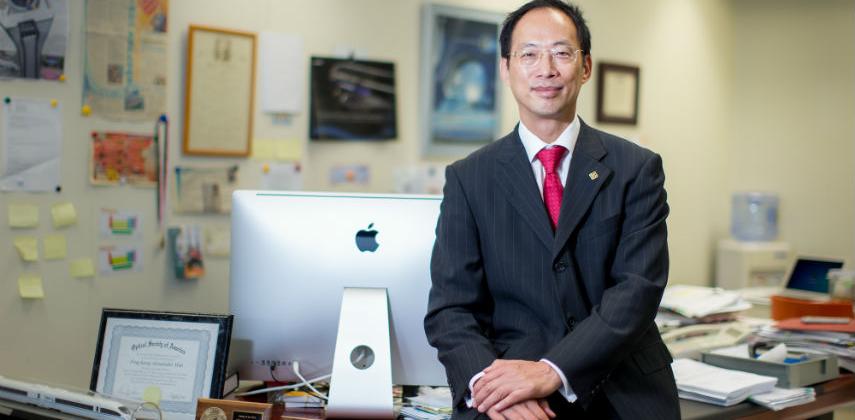PolyU is hiring 20 people for the management team of its industry-boosting Aviation Services Research Centre, writes Chris Davis.
As the aviation industry looks for better and more efficient ways to manufacture, maintain and service aircraft, Polytechnic University’s Aviation Services Research Centre (ASRC) aims to bridge the gap between academic research and industrial applications in the aviation industry.
The ASRC is a collaboration between Boeing, the world’s largest aerospace company, PolyU, and tier-one partners Hong Kong Aero Engine Services (HAESL) and sister company Hong Kong Aircraft Engineering Company (HAECO). The ASRC has also received funding from the government’s Innovation and Technology Commission.
PolyU’s vice-president of research development, Professor Alexander Wai Ping-kong, who is also CEO of the ASRC, says the establishment of Hong Kong’s first such research centre further reinforces the city’s importance as a premier aviation hub and underlines PolyU’s capability to conduct high-level research work.
He adds that the centre was established not to produce academic papers, but solutions that can improve and benefit Hong Kong’s aviation service industry.
Research work will focus on areas that are relevant to the needs of the local and wider aviation industry. “[This] may include the way new materials are used and ways to improve maintenance, repair and overhaul processes,” Wai says.
Research topics are requested by industry partners, ensuring that work provides lasting value. “Not surprisingly, Boeing does not undertake such ventures lightly and proceeded with the collaboration following a very thorough investigation of our ideas and capabilities,” Wai says.
He adds that the centre was established not to produce academic papers, but solutions that can improve and benefit Hong Kong’s aviation service industry.
Research work will focus on areas that are relevant to the needs of the local and wider aviation industry. “[This] may include the way new materials are used and ways to improve maintenance, repair and overhaul processes,” Wai says.
Research topics are requested by industry partners, ensuring that work provides lasting value. “Not surprisingly, Boeing does not undertake such ventures lightly and proceeded with the collaboration following a very thorough investigation of our ideas and capabilities,” Wai says.
There are also vacancies for two senior engineer and project leads: one in re-engineering and MRO, and one in digital technologies and automation. Candidates for the former should be familiar with service research, manpower development and business information exchange, and show the ability to manage multiple projects at once. For the latter, candidates should be able to show that they are capable of supporting the design and manufacture of bespoke machines and developing skilled manual techniques and advanced computational technologies.
“Who we recruit will in some ways determine the work we can do in the future, because no single person or research centre can have all the expertise needed to carry out research in such a complex industry,” Wai says.
The new venture adds an extension to PolyU’s collaborative relationship with HAESL and HAECO in designing, developing and producing equipment in support of repair and overhaul activities.
To further strengthen the ASRC’s capabilities, Wai says, the 100 or so staff members at the PolyU Industrial Centre, made up of about a third engineers and the remainder technicians, will be invited to assist with ASRC projects.
Wai says in addition to providing support for maintenance, repair and overhaul (MRO) services, the ASRC will support efforts to attract young people to the aircraft maintenance industry. “In the future, we hope to offer programmes that will encourage young people to make aviation engineering their career choice,” Wai says.
However, while demand for MRO services in Hong Kong continues to grow, the industry faces a problem that plagues many other business sectors – a lack of fresh talent. Presently, Hong Kong’s MRO providers employs about 6,000 staff. Through collaboration with universities and vocational training institutes, HAECO is looking to build headcount through recruitment programmes and graduate training schemes.
“There are excellent opportunities in the aviation engineering industry, but young people in Hong Kong seem to be drawn more towards the financial services industry where they think the work is easier and the rewards greater,” Wai says.
The 65,000-strong workforce that makes up Hong Kong’s airport services community serves is a key contributor to Hong Kong’s the city’s position as a leading international and regional aviation centre, he adds.
According to aviation consulting service TeamSAI, Asian MRO providers will see their market share in revenue streams grow from US$13.9 billion this year to US$24.3 billion by 2023. On the mainland, where MRO business is currently worth US$3.6 billion, TeamSAI expects revenues to more than double to US$7.8 billion during the same period. Aeronautics is one of the seven “rising” industries identified in the central government’s 12th five-year plan.


